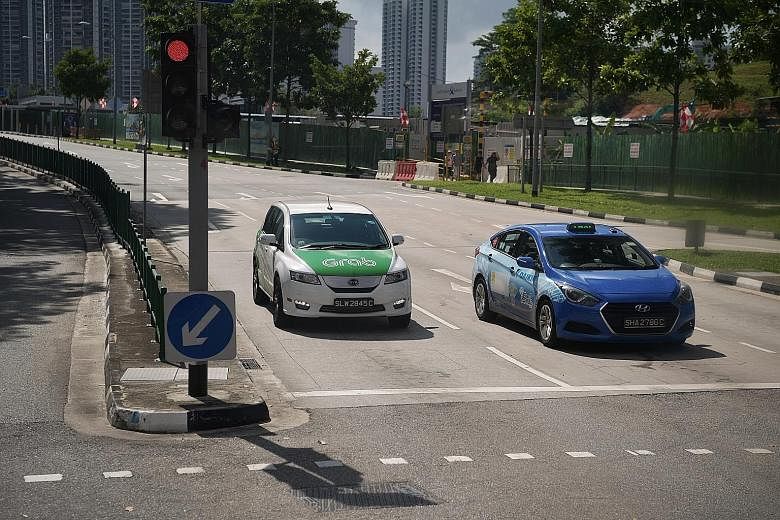A long-delayed regulatory framework to level the playing field between cabbies and private-hire drivers will kick in soon.
Asked for an update on the regulatory framework for the point-to-point (P2P) transport sector, the Land Transport Authority (LTA) said it would start later this month.
The framework has been in the works for about three years now, with the passing of the P2P Passenger Transport Industry Act in August last year.
The framework was to have taken effect by June this year. But because of the Covid-19 crisis, which has disrupted transport demand, it was postponed to last month, and then to this month.
The Straits Times understands that the framework will take effect in the latter half of the month.
With it, operators will incur licensing fees that are pegged to their respective revenue.
For a street-hail service licence, which allows drivers to pick up passengers on the street, the fee is 0.3 per cent of the licensee's gross annual revenue.
For a ride-hailing licence, which restricts a licensee to only phone-hailed rides, operators are to pay a fee equivalent to 0.6 per cent of their gross revenue.
While the framework is expected to address an uneven playing field, stakeholders and observers reckon more can be done.
A Grab spokesman said that while the company "supports the intent" of the framework, all ride-hail and carpool platform operators should be required to build in-app safety features such as number masking, an emergency button, sharing of real-time ride location and driver identity authentication.
She said child seats should also be a requirement for both private-hire cars and taxis. They are currently not required for the latter.
Addressing the anti-competitive clause of the framework, Grab said the "current inconsistency whereby taxi operators can restrict their drivers from taking fixed-fare jobs on other platforms" should be addressed "as soon as possible".
-
Framework at a glance
-
• Operators with 800 or more vehicles need to be licensed. Smaller operators are exempt but have to meet basic safety standards.
• Operators providing both street-hailing and ride-hailing services need to hold separate licences.
• Carpooling platforms with 800 or more vehicles will also need to obtain a licence.
• Operators can be sanctioned if their drivers are involved in too many accidents or commit too many offences.
• All private-hire cars will need to go for annual vehicle inspection.
• Exclusive arrangements preventing drivers from switching platforms will not be allowed.
• Taxi availability standards, such as requiring taxi operators to maintain at least 80 per cent of their taxis on the road during peak hour, to be removed.
• Licensed operators need to provide the Land Transport Authority (LTA) with trip and driver-related data.
• LTA can also issue codes of practice for licensees.
• The Public Transport Council will have powers to ensure that fares are clear and communicated upfront.
• Fare evasion and overcharging offences will be extended to private-hire car trips.
• LTA can fix maximum or minimum number of authorised drivers a licensed operator may have.
Singapore University of Social Sciences transport economist Walter Theseira said: "The most important thing about the P2P framework is that, in principle, it gives LTA similar powers over both taxi operators and private-hire firms."
But Associate Professor Theseira said the framework does not level the playing field completely.
"An area which remains an obvious problem is the difference in regulatory treatment of taxis and private-hire cars. Taxi operators continue to suffer from a lack of flexibility," he said.
"Taxis cannot be repurposed readily. Private-hire cars have always had flexibility to be converted to being a normal passenger car."
This becomes a big sticking point "when you have a big downturn like this", Prof Theseira added.
"For the same reason, when there is a sharp recovery, private-hire fleets can expand quickly, but taxis can't unless the regulatory framework becomes more flexible."
Mr Ang Hin Kee, adviser to the National Taxi Association and the National Private Hire Vehicles Association, said companies should go beyond their business of matching drivers to passengers.
"Take up the responsibility of helping drivers with their Medisave, retirement and training needs," he suggested.
He said that while drivers are not employees, they are key to the success of these businesses.
"Platforms need to work with car rental companies to ensure that they cannot disassociate themselves from responsibilities to the drivers just because one leases the car and the other matches passengers."
Mr Ang said ride-hailing platforms should also "level up" their contribution to the financial aid given to drivers during this pandemic.


